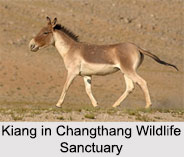 Changthang Wildlife Sanctuary located in Ladakhi Changthang plateau in the Leh district of Jammu and Kashmir, is one of most popular sanctuaries of Ladakh region. Along with its picturesque landscape, this sanctuary houses a large variety of flora and fauna. Spread over an area of about 4000 sq. km, the sanctuary is the home of the highest lake on earth, the Tso Moriri Lake. It is considered as the second largest nature reserve after the Northeast Greenland National Park. The sanctuary is located at an altitude of 14,000-19,000 feet.
Changthang Wildlife Sanctuary located in Ladakhi Changthang plateau in the Leh district of Jammu and Kashmir, is one of most popular sanctuaries of Ladakh region. Along with its picturesque landscape, this sanctuary houses a large variety of flora and fauna. Spread over an area of about 4000 sq. km, the sanctuary is the home of the highest lake on earth, the Tso Moriri Lake. It is considered as the second largest nature reserve after the Northeast Greenland National Park. The sanctuary is located at an altitude of 14,000-19,000 feet.
Flora of Changthang Sanctuary
Changthang Wildlife Sanctuary is the abode of almost 200 species of wild plants that grow in the higher pastures and they serve as the food for the animals inside the sanctuary. Seven rare and endangered plants with certain medicinal properties have been discovered in the sanctuary. Some of those species are listed as vulnerable and endangered on the IUCN Red List.
Fauna of Changthang Sanctuary
Among the incredible variety of wildlife in the Changthang Sanctuary, the major attraction of this place is Snow Leopard. Along with that, Changthang Wildlife Sanctuary is one of the few places in India which is the abode of the Kiang or Tibetan wild Ass along with the Dark-necked crane. Apart from the Snow Leopard and Kiang, Changthang Wildlife Sanctuary houses a huge variety of animal species which include Tibetan Wolf, Wild Yak, Bharal, Brown Bear, Tibetan Argali, Tibetan Gazelle and the Mormot. This place also serves as the habitat for numerous species of avifauna including Brahminy Ducks and Brown Headed Gulls etc. Around 44 types of water birds and seasonal species of migratory birds are often found here.
Nearby Places of Changthang Wildlife Sanctuary
Korzok village is located near to Changthang Wildlife Sanctuary, which is considered to be the world"s highest village. The main attraction of this village is the Korzok Monastery. Other nearby places of Changthang Wildlife Sanctuary are Pangong Tso Lake, Tso Kar Lake, Khardung La Pass and Shanti Stupa.
Visiting Information to Changthang Wildlife Sanctuary
The best time to visit the Changthang Wildlife Sanctuary is between the months of May and December because of its soothing weather. Leh Airport is the nearest airport and nearest railway station is Udhampur Railway Station to reach the place. This sanctuary can also be reached by road from Manali or Srinagar via Leh.



















